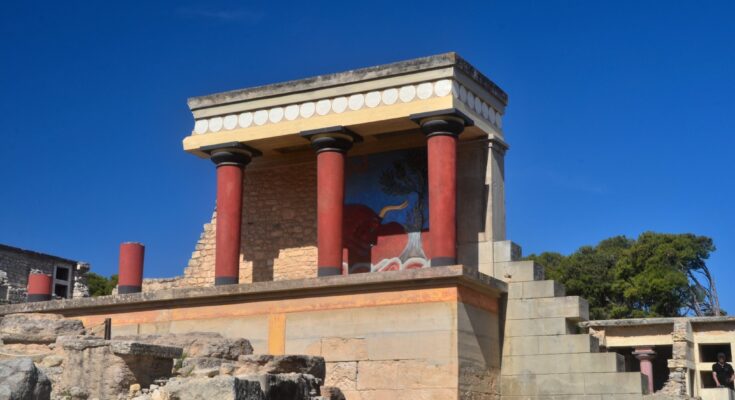According to Greek mythology, King Minos was a powerful king of Crete in the heroic age. He was the enemy of Theseus of Athens. Over the years, archaeologists have confirmed the existence of various entities and events from Greek mythology. What about in the case of this king? Is there any evidence that King Minos was a real person?
Who was King Minos?
To be able to analyze the potential evidence surrounding this king, we first need to know who he was actually supposed to have been. Ancient Greek sources agree he was a powerful king of Crete. Perhaps the best and simplest description of his reign comes from Thucydides. He also happens to be one of the earliest sources for this king. He wrote:
“And the first person known to us by tradition as having established a navy is Minos. He made himself master of what is now called the Hellenic sea, and ruled over the Cyclades, into most of which he sent the first colonies, expelling the Carians and appointing his own sons governors.”
In other words, King Minos essentially created a sea-empire, or thalassocracy, which covered the Cyclades. Other sources, such as Homer, confirm that he ruled from Crete. Thucydides goes on to state that the inhabitants of Minos’ islands “now began to apply themselves more closely to the acquisition of wealth, and their life became more settled,” mentioning their “newly-acquired riches.”
When did King Minos live?
Now let us consider the issue of when King Minos actually lived. So as to be able to assess any potential evidence of his existence, we obviously need to look at the relevant time period.
King Minos is usually placed about a generation or two prior to the Trojan War. Thucydides was one writer who mentioned this fact. However, the date of the Trojan War itself is the subject of considerable debate among scholars.
While traditionally dated to the twelfth century BCE, there are scholars who date it to the tenth, ninth, or even eighth century BCE. This latter position has support from some of the earliest information regarding the date of the war.
Perhaps more helpful is the fact that King Minos was the enemy of Theseus of Athens. This is an important part of the legend of this king. The legend of Theseus attributes to him the unification of Attica. Archaeology makes it quite clear that this occurred, historically, in the eighth century BCE.
Archaeological evidence for King Minos’ reign
On this basis, it would appear that King Minos most likely lived in the eighth century BCE. There is no basis whatsoever for the common suggestion that he was a king of the Bronze Age Minoan civilization. On the contrary, everything indicates he was a Greek king.
The first observation is that there is no contemporary inscription proving that King Minos was real. However, while archaeology has not revealed the existence of him as an individual, it may well reveal confirmation of his reign as described by Thucydides.
Recall that Thucydides claimed that King Minos ruled over the Cyclades and that they prospered as a result. Interestingly, archaeology has confirmed that the Cyclades did indeed prosper during the eighth century BCE.
In fact, it was exactly the eighth century BCE that saw the start of a new era of wealth and prosperity for these islands. The Encyclopedia Britannica, for example, notes that the Cyclades “flourished in the 8th to 6th century BCE.” One specific example is the island of Paros about which one modern source says:
“The 8th century BC was a prosperous period in the history of Paros, as the island became a maritime power.”
It is conspicuous that this period of prosperity and power coincides exactly with when King Minos would have lived.
Evidence from Crete
So far, we have seen that the archaeology of the Cyclades is consistent with what Thucydides wrote concerning Minos. However, Minos was fundamentally associated with Crete. That was apparently his home island and evidently the center of his sea-empire. Is there any evidence corroborating his reign on that island?
Firstly, we should note that Greek legend connects King Minos specifically to the city of Knossos, with its grand Minoan palace complex. To be clear, King Minos was not a Minoan king. Nonetheless, the Greeks continued to use Knossos for some time after they conquered Crete in the fifteenth century BCE.
However, Knossos was then destroyed towards the end of the Bronze Age. Does this mean that King Minos of Knossos cannot have been real because there was no settlement for him to rule over in the eighth century BCE?
On the contrary, archaeological evidence is clear that a new settlement had begun being built up on the outskirts of Minoan Knossos even before the eighth century BCE. Regarding the legendary labyrinth of Knossos, researchers generally associate this with the labyrinthine palace complex of that city.
Notably, there is evidence that a cult was established in that very palace complex, incorporating the Central Court, in the ninth century BCE. It is believed to have continued for many centuries thereafter. This confirms it was in use during the era of King Minos, as it should have been if he was real.



